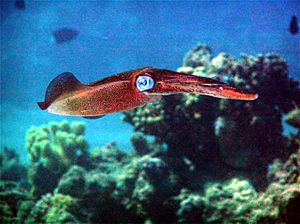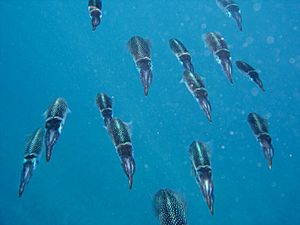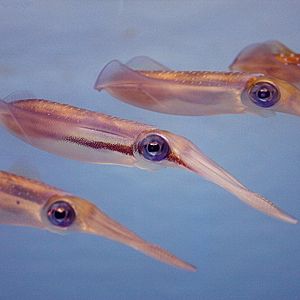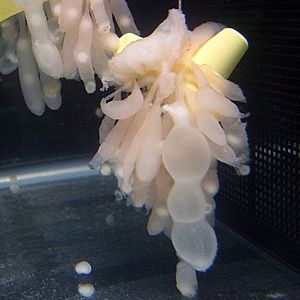Bigfin reef squid facts for kids
Quick facts for kids Bigfin reef squidSepioteuthis lessoniana |
|
|---|---|
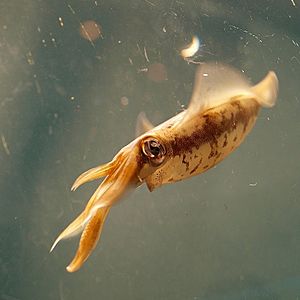 |
|
| A bigfin reef squid from the Tokyo Sea Life Park, Tokyo, Japan | |
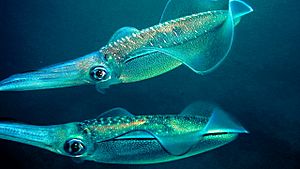 |
|
| A pair of bigfin reef squid found off the northeast coast of Taiwan | |
| Scientific classification | |
| Genus: |
Sepioteuthis
|
| Species: |
lessoniana
|
 |
|
| Estimated native range of the bigfin reef squid | |
| Synonyms | |
|
|
The bigfin reef squid (Sepioteuthis lessoniana) is also known as the glitter squid or oval squid. It is a type of squid that looks a bit like a cuttlefish because of its large, oval fins. These fins run along almost its entire body.
Bigfin reef squids are small to medium-sized. They usually grow to be about 3.8 to 33 centimeters (1.5 to 13 inches) long. They are known for their amazing color-changing abilities, even as babies! They also grow very fast, reaching about 600 grams (1.3 pounds) in just four months. However, they don't live very long, usually less than a year.
These squids mostly eat crabs and small fish. You can find them in the warm waters of the Pacific Ocean and Indian Ocean. They like to stay near the shore, especially around rocks and coral reefs. People in Asia catch a lot of them for food. Because they grow so quickly and are easy to keep, bigfin reef squids are important for mariculture (raising sea animals for food). They are also used in medical research because of their special giant nerves.
Contents
What is a Bigfin Reef Squid?
The bigfin reef squid is one of three types of squids in the Sepioteuthis group. Scientists think there might be more very similar species that are hard to tell apart.
How Bigfin Reef Squids Got Their Name
The scientific name Sepioteuthis lessoniana means "cuttlefish squid." This is because their large fins make them look like cuttlefish. They were first described by a French naturalist named André Étienne d'Audebert de Férussac. He named them after René Lesson, who collected the first specimen.
In different places, these squids have many common names:
- In Australia and New Zealand, they are called "northern calamary."
- In Japan, they are known as aori-ika.
- In Korea, they are called munuiojing-eo.
Physical Features of Bigfin Reef Squids
Bigfin reef squids have thick, muscular fins that go almost all the way around their body. These fins make up a large part of their length and width. A thin blue or white line shows where the fins attach to their body.
Their bodies are shaped like a cylinder and get narrower at the back. Males are usually 4 to 33 cm (1.6 to 13 in) long, and females are 3.8 to 25.6 cm (1.5 to 10 in) long. Both can grow up to 38 cm (15 in). Adult males weigh about 403.5 to 1415 grams (0.9 to 3.1 pounds), while females weigh 165 to 1046 grams (0.4 to 2.3 pounds). The heaviest recorded squid was 1.8 kg (4 pounds).
Their eyes are big and greenish. They have eight arms, which are different lengths. The third pair of arms is the longest. All arms have two rows of suckers. Males have a special arm called a hectocotylus on their left fourth arm. This arm is used for reproduction. They also have two long, thick tentacles with suckers at the ends.
Amazing Color Changes
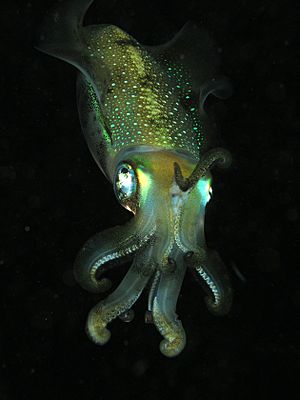
Bigfin reef squids can change their body color and patterns very quickly. They do this using special cells called chromatophores. These cells are dense on their upper body, head, and arms. They also have iridophores, which create shiny, metallic green and red colors when light hits them.
What's really cool is that baby bigfin reef squids can make complex body patterns right after they hatch! Other types of squids don't develop this ability until they are much older.
Where Bigfin Reef Squids Live
Bigfin reef squids live in warm waters near the coast. They are usually found in waters from the surface down to about 100 meters (330 feet) deep. They like to stay close to the shore, especially near rocks and coral reefs. They are more active at night. During the day, they might move to deeper water or find places to hide. Young squids often hide under floating wood.
These squids are found across a wide area. Their natural home is in the Indian Ocean and the western Pacific Ocean. This includes places from Japan in the north to Australia and New Zealand in the south. Recently, they have also been found in the Mediterranean Sea. They likely got there through the Suez Canal, a process called Lessepsian migration.
What Bigfin Reef Squids Eat
Bigfin reef squids eat many different sea creatures. Their main foods are prawns and other crabs, as well as small fish. In studies, squids in tanks ate one fish every 2 to 25 hours.
These squids are also food for other animals. Larger fish like tuna, marlin, and swordfish hunt them.
Squid Parasites
Bigfin reef squids can have tiny creatures living on or inside them. These include a type of copepod (a tiny crustacean) called Doridicola similis and small worm-like creatures called dicyemids.
How Bigfin Reef Squids Behave
Bigfin reef squids often swim together in groups, which is called schooling or shoaling. Even very young squids stay close together. Unlike many other squid species, bigfin reef squids rarely eat each other. Groups can include squids of different sizes without the bigger ones attacking the smaller ones.
Attraction to Light
Bigfin reef squids are strongly attracted to light. They will move towards a light source. Scientists think this might be an automatic reaction. They react most strongly to underwater lights that are not too dim or too bright.
Can Squids Hear?
Scientists have studied bigfin reef squids to see if they can hear. Unlike fish, squids don't have air-filled swim bladders to help them hear. The studies showed that squids use their statocysts (organs mainly for balance) to sense vibrations. Bigfin reef squids can hear sounds between 400 Hz and 1500 Hz. They hear best at 600 Hz. This hearing ability helps them avoid predators, especially dolphins, which use echolocation to find prey.
Reproduction and Life Cycle
Bigfin reef squids have interesting ways of finding a mate. Males often show off their reproductive organs by making them appear bright white. This might tell other squids they are ready to mate. Males also do a "spread arms" display, where they tilt their body forward and spread their arms wide. This is thought to be a sign of aggression.
There are different ways bigfin reef squids mate. Sometimes, a male will swim upside down next to a female and quickly transfer sperm packets (spermatophores) to her mouth area. Other times, the male and female swim side by side, and the male uses a special arm to place sperm packets inside the female's body near where she lays eggs. This second method is usually more successful.
Mating often happens before the female lays her eggs, but it can also happen at the egg-laying sites. Males might stay near the female as she lays her eggs. Sometimes, smaller males might try to trick larger males by acting like females. They might even get sperm packets attached to their own mouths!
Laying Eggs and Hatching
Bigfin reef squids usually start laying eggs in May, but they can lay eggs all year, depending on the location. A female can lay between 20 and 1180 eggs in her lifetime. After laying her eggs, the female usually dies.
Females release their eggs, which are then covered in a jelly-like substance. This forms an egg 'capsule' that holds two to nine eggs. These capsules are laid in long strands on rocks, corals, plants, or submerged branches. The eggs are about 3 mm (0.12 in) wide when laid.
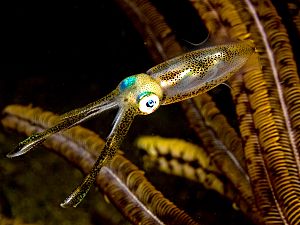
The eggs hatch in about three weeks, but this depends on the water temperature. In warmer places like Indonesia, they might hatch in just 15 to 16 days. When they hatch, the baby squids (called paralarvae) are about 6 mm (0.24 in) long. They look like tiny adults and can already swim well and change colors. They start swimming in schools about two weeks after hatching.
Young squids sometimes eat each other, especially if there are many of them in one place. However, this usually happens only if the eaten squid was already weak or dead.
Growth and Lifespan
Bigfin reef squids grow incredibly fast. They have one of the fastest growth rates of any large sea invertebrate. They can reach 600 grams (1.3 pounds) in just four months. Males become ready to reproduce earlier than females. In captivity, males mature in about 140 days, and females start laying eggs around 156 to 196 days after hatching.
In captivity, bigfin reef squids live for about 161 to 315 days. Warmer water temperatures might make them mature faster but also shorten their lives. Cooler temperatures can lead to longer lives and larger squids.
Importance to Humans
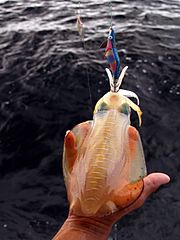
Bigfin reef squids are very important for fishing and are eaten by people all over the world. They are often caught using large nets or by jigging (fishing with a special lure). Fishermen often use bright lights at night to attract them, as the squids are drawn to light. They are also used as bait for other fish.
Because they grow so fast and are easy to keep in tanks, bigfin reef squids are a promising species for mariculture (farming sea animals).
Use in Science
Bigfin reef squids are special because they are the first squid species that scientists have been able to raise for more than one generation in a lab. They adapt well to living in tanks, which makes them great for studying.
These squids are also very important for medical research, especially in neuroscience. They have very large nerve cells (axons), much bigger than human ones. These giant nerves help the squid quickly jet away from danger. Scientists study them to learn more about how nerves work.
Bigfin Reef Squids and Climate Change
Bigfin reef squids might be a good sign of climate change. They adapt to warmer temperatures by laying more eggs. This means that as the oceans get warmer due to global warming, the number of bigfin reef squids might increase a lot. Overfishing of their natural predators might also contribute to their rising numbers. Some scientists even call them "the weeds of the sea" because they can become so abundant.
Warmer waters may also help these squids spread to new areas where they didn't live before. Their recent appearance in the Mediterranean Sea is an example of this.
|
See also
 In Spanish: Calamar de arrecife para niños
In Spanish: Calamar de arrecife para niños



